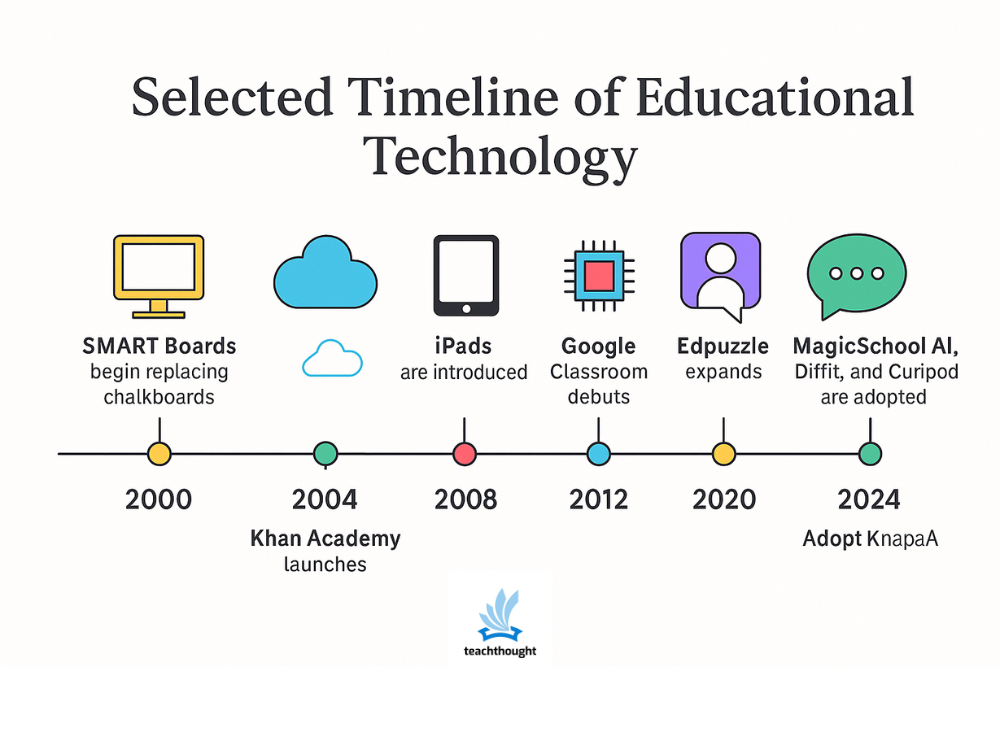2000-2003
Digital tools are starting to enter the classrooms, directed by interactive white tables and first online platforms like Blackboard. The basic work is thrown for the transition from analog methods to digital teaching methods.
- Intelligent plates are starting to replace Chalk paintings in American classrooms, offering early digital interactivity.
- Blackboard extends in higher education, the centralization of programs, missions and notes.
- Brainpop and Discovery Education is launching video and lesson resources based on kindergarten subscription to 12th year.
- Microsoft PowerPoint becomes a staple for teachers’ presentations and student projects.
2004-2007
Cloud tools and open source platforms take momentum. YouTube and Google Docs mark a turning point in collaboration and access to content.
- YouTube launches and begins its evolution in a major center for educational video content.
- Moodle appears as an open source LMS, allowing the provision of course and the follow -up of students.
- Google Docs presents a collaboration based on a real -time browser for writing tasks.
- The Maine Learning Technology initiative is developing laptop programs one to one nationally.
2008-2011
The rise of mobile devices – especially iPads – seems to reshape the way young learners access digital content. The Khan Academy establishes a precedent in free instruction and on demand.
- Khan Academy is launched with short mathematical tutorials, becoming a leader in free video education.
- The iPads were introduced in 2010 and quickly integrated into class K – 2 rooms for literacy and accessibility.
- The documents of documents replace the air projectors, allowing a dynamic display and an annotation of the printed content.
2012-2015
Google’s education ecosystem takes shape with the launch of the class and the generalized adoption of chromebooks. These years have established the standard for educational delivery first in clouds.
- Google Classroom made its debut in 2014, simplifying the distribution and collection of digital assignments.
- Chromebooks exceed iPads in American education for the first time, driven by the cost and integration of the cloud.
- The Nearpod and Pear Deck introduce an interactive commitment based on devices with slides and surveys.
2016-2019
Student’s vocal tools, interactive videos and survey formats gain popularity. This period focuses more on creation and commitment than access to content.
- Flipgrid allows asynchronous video answers for students, becoming popular in classrooms worldwide.
- Edpuzzle extends the use of integrated video questions for formative assessment.
- Adobe Spark (now Adobe Express) becomes a tool of choice for projects designed by students, assignments, etc.
- Hyperdocs emerge as Google Docs designed by the teacher for students based on students.
2020-2023
The COVVI-19 pandemic accelerates a large-scale adoption of digital education. Teachers adopt (because what choice had the most?) The asynchronous tools and AI come into educational conversation.
- Distance learning during the COVVI-19 pandemic leads to the mass adoption of zoom, Google Meet and teams.
- Teachers use screening and the loom to record asynchronous lessons and explanations.
- Khanmigo is launched as a tutor AI and AI teacher assistant to the Khan Academy.
- Wakelet, Padlet and Jamboard (which since by Sunset) has become popular for conservation, brainstorming and visual collaboration.
2024-2025
AI tools are starting to reshape the educational design, feedback and politics. Teachers adapt to a new era of automation, ethical dilemmas and content generation.
- Teachers adopt the AI of Magicschool, Difffit and Curipod to scaffold texts, differentiate tasks and quickly build materials.
- The districts implement policies on the generative use of AI, focusing on academic integrity and paternity.
- Professional development changes to highlight rapid engineering, alignment of AI and educational ethics.
- Educators rethin the evaluations to prioritize synthesis, the application of the real world and multimodal expression.





